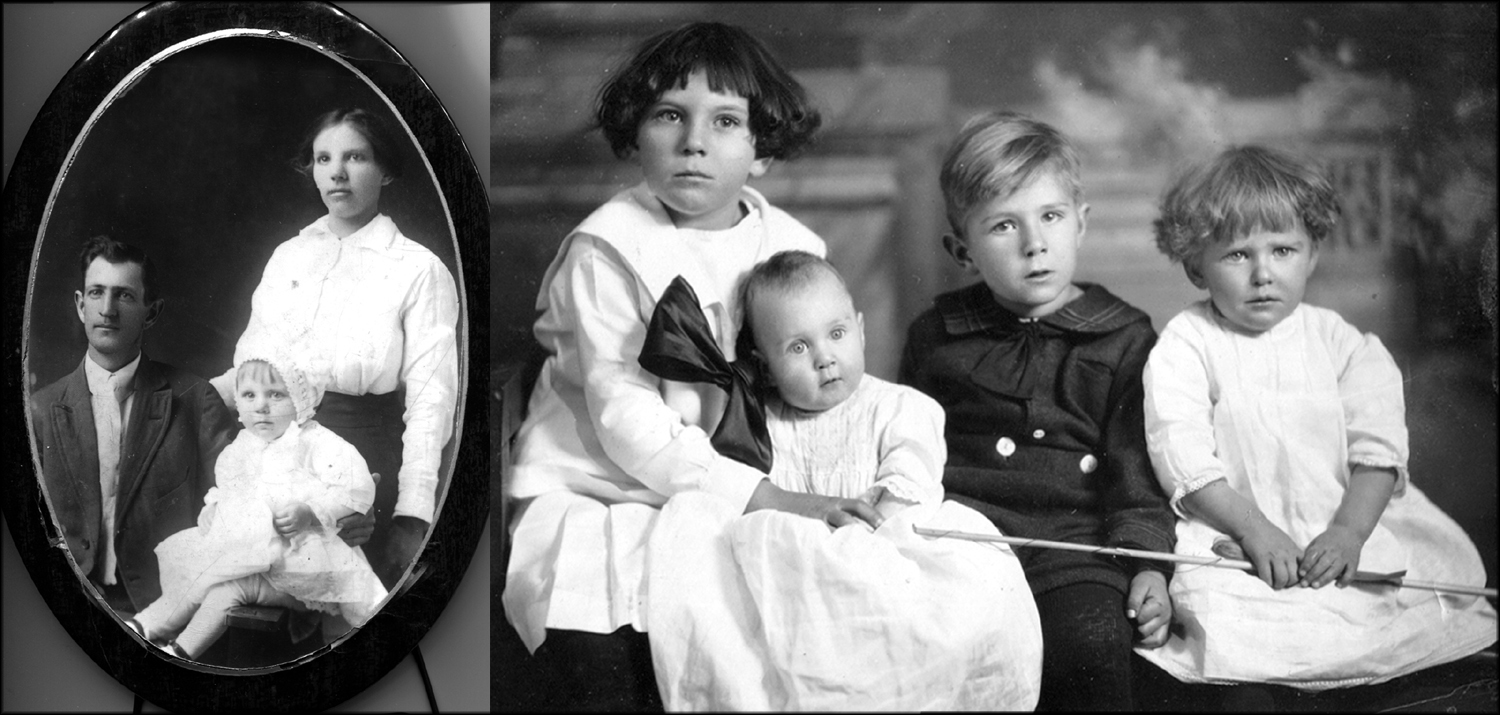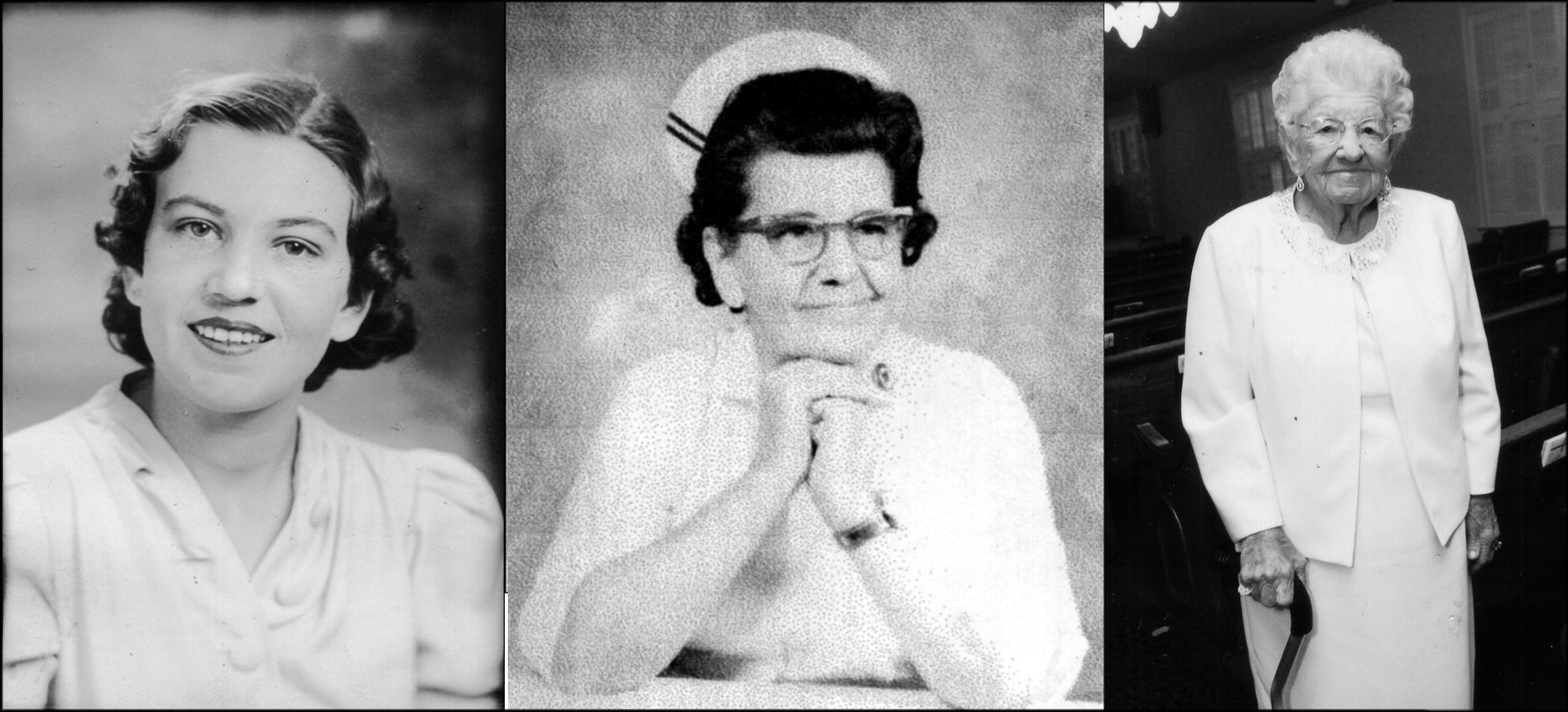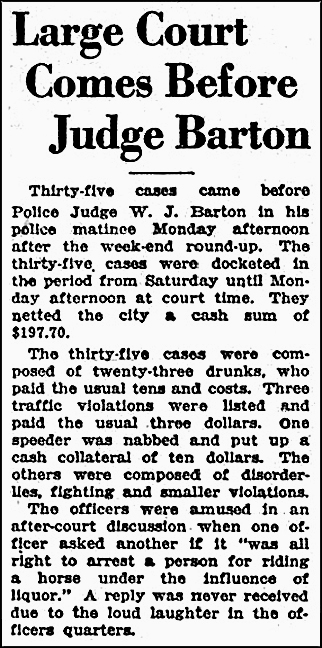I received a note from Betsy Shaw on behalf of her mother, Bessie Kate “Bess” Young Katcham who will be 100 years old on July 18. “Nothing would please her and her family more,” said Betsy, “than to have an interview with you about those 100 years in Johnson City and how everything has changed.”
During her life, Bess enjoyed the Johnson City Press and read every word from front to back. After being diagnosed with macular degeneration, Betsy continued to read the news to her. She especially loves area history articles and can personally relate to so many of them.

Left: Young Bess with Her Parents / Right: Bess (far left) and Her Sibblings
What do we know about the Young family? According to Ray Stahl from his book, Greater Johnson City- A Pictorial History (1983, The Donning Co.), the Young family members collectively acquired more than 2,000 acres that had been bought from the Cherokees, which was about the same amount as that sold under the Watauga Association sale. Bess can be proud of her Young family history.
Listed below are seven questions and answers provided by the soon-to-be centurion. Ms. Shaw interviewed her and supplied me with ample text and photos for this feature. Her comments are only slightly edited.
1. What is the background of the Young family?
“The Young family is one of the original families in this area. My father was Frank David Young and he was the baby of six children (that included Willie, George, Jim, Nannie and Ruth) born to Hattie Matilda Emaline Scott Young and Thomas Young. “My ancestor, Robert Young, and family were the inhabitants of the Young Cabin located at Winged Deer Park here in Johnson City. The cabin was originally located on Mckinley Road behind the Tennessee National Guard Armory. All the men of our family, including my father, were accomplished brick masons with the exception of Jim, who was an attorney.
“An example of my father's trade was the fact that he put the finishing round of brick on the John Sevier Hotel, a major downtown city landmark. The entire family rode the streetcar down Roan Street to the big celebration. “The advantage of being a brick mason during this time was that masons joined hands and built each other a brick home. We even had a brick outhouse that contained an expired Sears and Roebuck catalog in it. This home still stands at 2027 E. Unaka Avenue.
“My mother was born to Rebecca and Jim Blevins, who was the Tweetsie Railroad conductor, and was one of six children from a blended family. The stepfather was Tom White. He hauled slag from the old Carnegie furnace. When they dumped it daily, it lit up the entire sky of E. Johnson City at the end of the streetcar track on E. Fairview. Not many people, if any, are alive today would remember the fiery skyline. At the end of this streetcar track was the Commissary where “the furnace workers owed their souls to the company store.”

Bess and Her Husband, Willard in Their Younger Days
2. Did the Great Depression affect your life and that of your family?
“The Depression was not felt as much by my middle class family as it was by the upper and lower classes. I say this because we raised our own pork, beef and poultry. We also had a garden where we raised vegetables. We canned and preserved everything we could. My mother made our clothes out of flower sacks and she made lye soap out of pig fat in a brass kettle over a fire in the back yard.
“Part of the corn crop was taken to St. John's Mill on Watauga Road for grinding into corn meal and cracked corn for chicken feed. This mill still stands today but is not operational.
“What did affect us was rationing of such items as coffee. Also, the building industry was virtually at a stand still. My family had to sell our brick house and move to find work. We relocated to Morristown and resided there for a year before moving back to Johnson City. My parents were never to own another home. After reflecting on this, the Depression did severely affect us because nothing was ever the same for us.”
3. What do you remember about your school years?
“I attended grammar school at Piney Grove Elementary School and later Martha Wilder located on Myrtle Avenue in East Johnson City. I attended Junior High School on Roan Street. I walked 2.5 miles to school every day and on occasion was afforded a ride by Mr. St. John, owner of mill, as he also took his daughter, Josephine, to school in an automobile.
“My fondest memories were of climbing the magnificent steps of Science Hill High School. I spent two years there but had to move to Morristown for my junior year due to the Depression. My family returned to Johnson City after my junior year, but I never returned to school. Instead, I got a job working at McLellans 5 & 10 store.
4. What are some of the significant changes you observed in your life?
“We lived in our brick house several blocks past the Johnson City Country Club on East Unaka in my early childhood. There was no power or paved streets past the Club. We used a wood stove for cooking and coal stove for heat. We hah a wash board for washing. We had a cow, hogs, chickens and a garden which provided food.
“That all changed after the Depression. We moved into a rented house with no animals and no garden. We then became dependent on local stores for our groceries. We did, however, own a car because this was necessary for a brick mason to get to his job. This allowed us to visit family, go on picnics at the Unicoi County Fishery, the Laurels and Cox's Lake. We always picked blackberries at Fall Branch every July 4th.”

Bess in Her Wedding Dress / Bess Graduates from Nursing School / Bess at age 97
5. How did your life change in your early adulthood?
“My friend, Sweden Hodges Wilhoit, lived with my family during the week and we would ride the train from Johnson City to Boones Creek to his house on Saturday night and then ride back to Johnson City on the train Sunday after church. It was not unusual for my mother to allow my cousins to live with us during the summer when they were out of school.
“I later went to work at the hosiery mill (Johnson City Mills) just off New Street in East Johnson City. During this time, I looked out my window and saw Willard Katcham walking past my house. I said, 'what a good looking boy'. My mother replied after looking out the window, 'Stay away from that boy; he is too good looking and will be nothing but trouble.' Three years later I married Willard. I was living at the time in Johnson City.”
6. What were your later years like?:
“Willard and I raised three children: Carol, Larry and Betsy. We lived on Boone Street, which was then North Johnson City. I was a full time mom. We also lived in Kingsport for a time while Willard worked at Holston Ordnance Works. We moved back to Johnson City when Willard started working at Thomas Oil Company. We purchased our first new home in 1957 on the west side of Johnson City.
“Tragedy struck my life in 1958 when Willard died of a heart attack while on a deer scouting outing with our 15-year-old-son. My husband was only able to see one grandchild of six, Randy Lyle, and none of our great or great-great grandchildren.
“On Mother's Day on May 8, 1983, the Johnson City Press-Chronicle published a letter from my youngest daughter Betsy, depicting my challenges and recovery. I was able to rebuild my life to become an independent self supporting person through my continuous faith in God.”
 Left: Bess Standing in Front of the Robert Young Cabin / The Young Brick House in Johnson City
Left: Bess Standing in Front of the Robert Young Cabin / The Young Brick House in Johnson City
7. What are your best memories of growing up and living in Johnson City?
“We made our own skedaddle skate boards using a board and some skate wheels, which we played with all day. On the first day of summer, we dropped our shoes and went barefooted all summer until school started again.
“Outstanding memories include enjoying a soda upstairs at Anderson Drug Store; going to the movies at the Liberty Theater; walking to the annual Thanksgiving and Christmas parades; parking on Main Street with Willard and watching people walk by; following the iceman and getting small pieces of ice from the ice truck; receiving candy treats from Tolbert H. Kitts, Sr., who was known as the “Raleigh Man”; seeing our RFD mailman, Ray Mettetal, Sr. (father of Ray W. Mettetal); walking to Godsey Grocery (2103 E. Unaka) with a nickel or dime; purchasing my wedding dress from Masengill’s Department Store in 1936; and having lunch wagon breaks at the hosiery mill with an original six-ounce Coca Cola with mushy ice.”
Happy upcoming 100th birthday, Bess! The readers of the Johnson City Press thank you for sharing your much-loved memories of growing up in Johnson City.”






